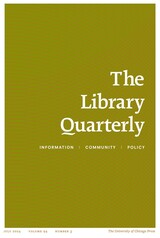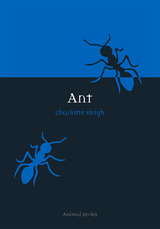
When we encounter them outdoors, ants fascinate us; discovered in our kitchen cupboards, they elicit horror and disgust. Charlotte Sleigh’s Ant elucidates the cultural reasons behind our varied reactions to these extraordinary insects, and considers the variety of responses that humans have expressed at different times and in different places to their intricate, miniature societies. Ants have figured as fantasy miniature armies, as models of good behavior, as infiltrating communists and as creatures on the borderline between the realms of the organic and the machine: in 1977 British Telecom hired ant experts to help solve problems with their massive information network.
This is the first book to examine ants in these and many other such guises, and in so doing opens up broader issues about the history of science and humans’ relations with the natural world. It will be of interest to anyone who likes natural history or cultural studies, or who has ever rushed out and bought a can of Raid™.
"[Charlotte Sleigh's] stylish, engaging and informative study deserves to win new members for the ant fan club."—Jonathan Bate, The Times
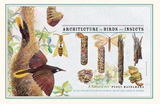
A visual celebration of these natural feats of engineering and ingenuity, Architecture by Birds and Insects allows readers a peek inside a wide range of nests, offering a rare opportunity to get a sense of the materials and methods used to build them. Here, we see the kinds of places where nests are built—for instance, the house wren has been known to occupy cow skulls, flower pots, tin cans, and the pockets of hanging laundry, while the uglynest caterpillar prefers rose bushes and cherry trees. Inspired by the vast nest collection at the Field Museum, which features specimens gathered throughout North and South America, Peggy Macnamara’s paintings are enhanced by text written by museum curators. This narrative provides a foundation in natural history for each painting, as well as fascinating anecdotes about the nests and their builders.
Like so many natural treasures, nests are easy to ignore. But Macnamara’s gorgeous paintings will undoubtedly change that. Architecture by Birds and Insects at last gives the tiniest engineers their rightful moment in the spotlight, and in so doing increases awareness and encourages the protection of birds, insects, and their habitats. Readers will never look at a Frank Gehry design, or a treetop nest, the same way again.
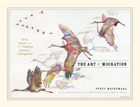
As the only artist in residence at the Field Museum, Peggy Macnamara has a unique vantage point for studying these patterns and capturing their distinctive traits. Her magnificent watercolor illustrations capture flocks, movement, and species-specific details. The illustrations are accompanied by text from museum staff and include details such as natural histories, notable features for identification, behavior, and how species have adapted to environmental changes. The book follows a gentle seasonal sequence and includes chapters on studying migration, artist’s notes on illustrating wildlife, and tips on the best ways to watch for birds and insects in the Chicago area.
A perfect balance of science and art, The Art of Migration will prompt us to marvel anew at the remarkable spectacle going on around us.
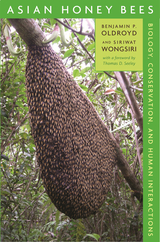
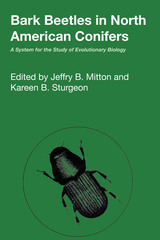
Because they prey upon a wide variety of conifers, bark beetles have a major impact upon western forests. In most of the western states, for example, we have witnessed bark beetles in epidemic outbreaks, attacking and damaging ponderosa pine, limber pine, and other hosts.
The ecosystem of bark beetle and host tree is a highly coevolved community of organisms in which the evolution of one member of the community significantly influences the evolution of the other. Largely because of the enormous economic impact these insects exert on the management of our forests, few other such communities have been studied so extensively. Bark Beetles in North American Conifers brings together in one volume both theory and a wealth of empirical data gathered by researchers from all the fields in which bark beetles are studied: ecology, evolutionary biology, population genetics, entomology, and forestry.
Topics covered include the life cycle of bark beetles and their population dynamics, their genetic variation and evolutionary mechanisms, the evolution and systematics of the major groups of bark beetles, pheromone production and its implications for coevolution among these organisms, the interaction between bark beetles and their predators, host resistance and susceptibility, the relationship of parasites and symbiotic micro-organisms in general, and management and control of bark beetles based on sound ecological and evolutionary concepts. The concluding section of the book summarizes the dynamics of the coevolved system of bark beetle and host tree and discusses controversial issues for which this system may provide important answers.
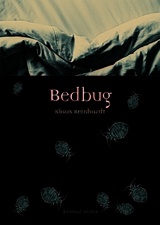
From fossils to classical Greek plays to the beds of medieval travelers, history is a rash of bedbugs. So ubiquitous and so loathed are these contentious creatures, the first recorded use of the insect moniker “bug” refers to them, a word that now means any sort of glitch or invader—from computer errors to snooping devices. Lifting the covers on this pestilential history, Reinhardt shows how bedbugs were not only the center of bitter fights among scientists, but also how the bugs’ dangerous aspects were foregrounded, and how bedbugs’ peculiar mating habits fueled public revulsion. Richly illustrated, full of the latest bedbug research, and sure to make you itch, Bedbug closes with a plea for sanguine tolerance—something humans and bedbugs will need alike as worldwide infestation rates soar.
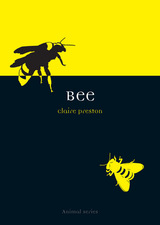
Bee traces the bee's role in art, politics, and social thought, drawing on scientific studies, literature, and historical texts. The volume examines the evolution of the bee's cultural image from a symbol of virtue and civility to the dangerous swarms of killer bees in Hollywood horror flicks. From ancient political analogies to Renaissance debates about monarchy to studies of bee behavior that portend ominous conclusions for our own socialization and use of technology, Bee analyzes the complex connections between the bee and human culture.
Written with energy and enthusiasm, Bee offers an original and fascinating meditation on this tiny workaholic.
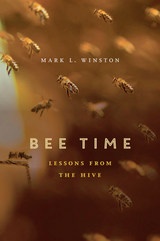
Being among bees is a full-body experience, Mark Winston writes—from the low hum of tens of thousands of insects and the pungent smell of honey and beeswax, to the sight of workers flying back and forth between flowers and the hive. The experience of an apiary slows our sense of time, heightens our awareness, and inspires awe. Bee Time presents Winston’s reflections on three decades spent studying these creatures, and on the lessons they can teach about how humans might better interact with one another and the natural world.
Like us, honeybees represent a pinnacle of animal sociality. How they submerge individual needs into the colony collective provides a lens through which to ponder human societies. Winston explains how bees process information, structure work, and communicate, and examines how corporate boardrooms are using bee societies as a model to improve collaboration. He investigates how bees have altered our understanding of agricultural ecosystems and how urban planners are looking to bees in designing more nature-friendly cities.
The relationship between bees and people has not always been benign. Bee populations are diminishing due to human impact, and we cannot afford to ignore what the demise of bees tells us about our own tenuous affiliation with nature. Toxic interactions between pesticides and bee diseases have been particularly harmful, foreshadowing similar effects of pesticides on human health. There is much to learn from bees in how they respond to these challenges. In sustaining their societies, bees teach us ways to sustain our own.
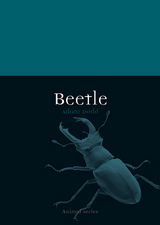

When the first birds appeared on earth about 150 million years ago, the insects were here to greet them. Inevitably the two groups came to exploit each other, and as the eons passed, they became increasingly enmeshed in a complex web of interrelationships--birds eating bugs, blood-sucking insects feeding on birds, parasitic insects infesting birds, and birds struggling to rid themselves of the parasites. In The Birder's Bug Book Gilbert Waldbauer, a veteran entomologist and an accomplished birdwatcher, describes these and many other interactions between birds and insects. A beguiling blend of anecdote, ornithology, and entomology, rendered in the engaging style that has won over scientists and amateur naturalists alike, this book is an excellent introduction to the intricate interplay of insects and birds.
With the birds and the bees it's not so much sex as mutual exploitation. Most birds feed mainly on insects, taking them from the air, from vegetation, and from deep within wood. The insects fight back by camouflaging themselves or by mimicking insects that birds find unpalatable. Many insects suck blood from birds or infest them, lodging in their feathers and nests. The birds fight back by preening, by taking dust or water baths to discourage lice and other bugs, and even by rubbing themselves with ants, whose formic acid repels many insects.
As entertaining as it is informative, The Birder's Bug Book will appeal to all those interested in birds, bugs, and natural history. Profusely illustrated with drawings and color photographs, this book offers a cornucopia of facts about the life history and behavior of insects and birds.
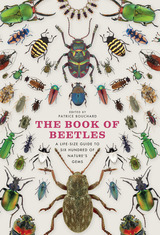
The Book of Beetles celebrates the beauty and diversity of this marvelous insect. Six hundred significant beetle species are covered, with each entry featuring a distribution map, basic biology, conservation status, and information on cultural and economic significance. Full-color photos show the beetles both at their actual size and enlarged to show details, such as the sextet of spots that distinguish the six-spotted tiger beetle or the jagged ridges of the giant-jawed sawyer beetle. Based in the most up-to-date science and accessibly written, the descriptive text will appeal to researchers and armchair coleopterists alike.
The humble beetle continues to grow in popularity, taking center stage in biodiversity studies, sustainable agriculture programs, and even the dining rooms of adventurous and eco-conscious chefs. The Book of Beetles is certain to become the authoritative reference on these remarkably adaptable and beautiful creatures.
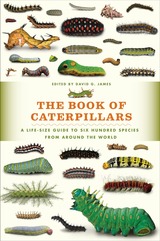
The Book of Caterpillars unveils the mysteries of six hundred species from around the world, introducing readers to the complexity and beauty of these underappreciated insects. With the advent of high-quality digital macrophotography, the world of caterpillars is finally opening up. The book presents a wealth of stunning imagery that showcases the astonishing diversity of caterpillar design, structure, coloration, and patterning. Each entry also features a two-tone engraving of the adult specimen, emphasizing the wing patterns and shades, as well as a population distribution map and table of essential information that includes their habitat, typical host plants, and conservation status. Throughout the book are fascinating facts that will enthrall expert entomologists and curious collectors alike.
A visually rich and scientifically accurate guide to six hundred of the world’s most peculiar caterpillars, this volume presents readers with a rare, detailed look at these intriguing forms of insect life.
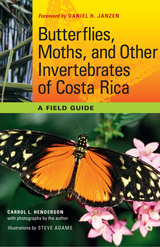
At the biological crossroads of the Americas, Costa Rica hosts an astonishing array of plants and animals—over half a million species! Ecotourists, birders, and biologists come from around the world, drawn by the likelihood of seeing more than three or four hundred species of birds and other animals during even a short stay. To help all these visitors, as well as local residents, identify and enjoy the wildlife of Costa Rica, Carrol Henderson published Field Guide to the Wildlife of Costa Rica in 2002, and it instantly became the indispensable guide.
Now Henderson has created a dedicated field guide to more than one hundred tropical butterflies, moths, and other invertebrates that travelers are most likely to see while exploring the wild lands of Costa Rica. He includes fascinating information on their natural history, ecology, identification, and behavior gleaned from his forty years of travels and wildlife viewing, as well as details on where to see these remarkable and beautiful creatures. The butterflies, moths, and other invertebrates are illustrated by over 180 stunning and colorful photographs—most of which were taken in the wild by Henderson. A detailed and invaluable appendix that identifies many of Costa Rica's best wildlife-watching destinations, lodges, and contact information for trip-planning purposes completes the volume.
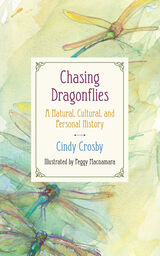
Chasing Dragonflies: A Natural, Cultural, and Personal History is an engaging, beautifully illustrated introduction to these remarkable insects. Drawing on her experiences as a natural history instructor, dragonfly monitor, cancer survivor, grandmother, and steward, Crosby tells the stories of dragonflies: their roles in poetry and art, their fascinating sex life—unique within the animal kingdom—and their evolution from dark-water dwellers to denizens of the air. We follow Crosby and other citizen-scientists into the prairies, wetlands, and woodlands of the Midwest, where they observe the environment and chronicle dragonfly populations and migration to decipher critical clues about our changing waterways and climate.
Woven throughout are personal stories: reflections on the author’s cancer diagnosis and recovery, change, loss, aging, family, joy, and discovering what it means to be at home in the natural world. Crosby draws an intimate portrait of a landscape teeming with variety and mystery, one that deserves our attention and conservation. As warm as it is informative, this book will interest gardeners, readers of literary nonfiction, and anyone intrigued by transformation, whether in nature or our personal lives.
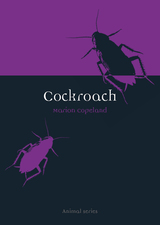
Attempts to chronicle the cockroach’s intellectual and emotional life have been made only within the last century when a scientist titled his essay on the cockroach "The Intellectual and Emotional World of the Cockroach", and artists as radically different as Franz Kafka and Don Marquis created equally memorable cockroach protagonists.
At least since Classical Greece, authors have brought cockroach characters into the foreground to speak for the weak and downtrodden, the outsiders, those forced to survive on the underside of dominant human cultures. Cockroaches have become the subjects of songs (La Cucaracha), have competed in "roachraces" and have even ended up in recipes. In this accessible, sympathetic and often humorous book, Marion Copeland examines the natural history, symbolism and cultural significance of this poorly understood and much-maligned insect.
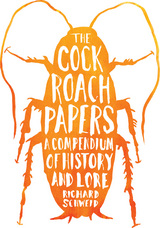
Traveling from New York City to Louisiana, Mexico, Nicaragua, and Morocco, Schweid blends stories of his own squirm-inducing roach encounters with meticulous research to spin a tale both humorous and harrowing. As he investigates roaches’ more nefarious interactions with our species—particularly with those of us living at the margins of society—Schweid also explores their astonishing diversity, how they mate, what they’ll eat, and what we’ve written about them (from Kafka and Nelson Algren to archy and mehitabel). Knowledge soon turns into respect, and Schweid looks beyond his own fears to arrive at an uncomfortable truth: We humans are no more peaceful, tidy, or responsible about taking care of the Earth or each other than these tiny creatures that swarm in the dark corners of our minds, homes, and cereal boxes.
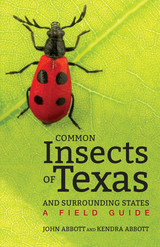
Thanks to its size and geographic position, Texas is home to nearly 30,000 species of insects, likely making its insect population the most diverse in the nation. Ranging from eastern and western to temperate and tropical species, this vast array of insects can be difficult to identify. In Common Insects of Texas and Surrounding States, John and Kendra Abbott have created the state's most comprehensive field guide to help readers recognize and understand these fascinating creatures.
Containing 1,300 species and more than 2,700 photographs, this guide offers a wealth of information about the characteristics and behaviors of Texas's insects. Each chapter introduces an order with a discussion of general natural history and a description of other qualities helpful in distinguishing its various species, while every species' entry provides a state map showing where it is most likely to be found, a key displaying its seasonal distribution, information about its habitat, and corresponding photos. Featuring colored tabs for quick reference, a glossary, and information about other arthropods, this guide is the perfect companion for anyone wanting to identify and learn more about the many insects of Texas.

At a time when night-singing insects have slipped beyond our notice—indeed, are more likely to be heard as NatureSounds than in a backyard—John Himmelman seeks to reconnect us to creatures whose songs form a part of our own natural history.
On warm summer evenings, night-singing insects produce a whirring, chirping soundscape—a calming aural tapestry celebrated by poets and naturalists for millennia. But “cricket radio” is not broadcast for the easy-listening pleasure of humans. The nocturnal songs of insects are lures and warnings, full of risks and rewards for these tiny competitive performers. What moves crickets and katydids to sing, how they produce their distinctive sounds, how they hear the songs of others, and how they vary cadence, volume, and pitch to attract potential mates, warn off competitors, and evade predators is part of the engaging story Cricket Radio tells.
Himmelman’s narrative weaves together his personal experiences as an amateur naturalist in search of crickets and katydids with the stories of scientists who study these insects professionally. He also offers instructions for bringing a few of the little singers into our homes and gardens. We can, Himmelman suggests, be reawakened to these night songs that have meant so much to the human psyche. The online insect calls that accompany this colorfully illustrated narrative provide a bridge of sound to our past and to our vital connection with other species.
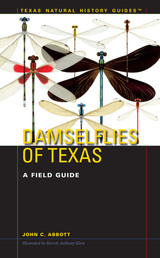
On any warm summer day, you can easily observe damselflies around a vegetated pond or the rocks along the banks of a stream. Like the more familiar dragonfly, damselflies are among the most remarkably distinctive insects in their appearance and biology, and they have become one of the most popular creatures sought by avocational naturalists.
Damselflies of Texas is the first field guide dedicated specifically to the species found in Texas. It covers 77 of the 138 species of damselflies known in North America, making it a very useful guide for the entire United States. Each species account includes:
- illustrations of as many forms (male, female, juvenile, mature, and color morphs) as possible
- common and scientific names, with pronunciation
- distribution map
- key features
- identifying characteristics
- discussion of similar species
- status in Texas
- habitat, seasonality, and general comments
In addition to photographing damselflies in the wild, the author and illustrator have developed a new process for illustrating each species by scanning preserved specimens and digitally painting them. The resulting illustrations show detail that is not visible in photographs. The book also contains chapters on damselfly anatomy, life history, conservation, names, and photography, as well as a list of species that may eventually be discovered in Texas, state and global conservation rankings, seasonality of all species in chronological order, and additional resources and publications on the identification of damselflies.
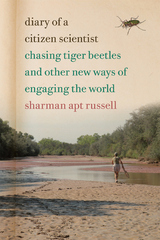
In the exploding world of citizen science, hundreds of thousands of volunteers are monitoring climate change, tracking bird migrations, finding stardust for NASA, and excavating mastodons. The sheer number of citizen scientists, combined with new technology, has begun to shape how research gets done. Non-professionals become acknowledged experts: dentists turn into astronomers and accountants into botanists.
Diary of a Citizen Scientist is a timely exploration of the phenomenon of citizen science, told through the lens of nature writer Sharman Apt Russell’s yearlong study of a little-known species, the Western red-bellied tiger beetle. In a voice both humorous and lyrical, Russell recounts her persistent and joyful tracking of an insect she calls “charismatic,” “elegant,” and “fierce.” Patrolling the Gila River in southwestern New Mexico, collector’s net in hand, she negotiates the realities of climate change even as she celebrates the beauty of a still-wild and rural landscape.
Russell’s self-awareness—of her occasionally-misplaced confidence, her quest to fill in “that blank spot on the map of tiger beetles,” and her desire to become newly engaged in her life—creates a portrait not only of the tiger beetle she tracks, but of the mindset behind self-driven scientific inquiry. Falling in love with the diversity of citizen science, she participates in crowdsourcing programs that range from cataloguing galaxies to monitoring the phenology of native plants, applauds the growing role of citizen science in environmental activism, and marvels at the profusion of projects around the world.
Diary of a Citizen Scientist offers its readers a glimpse into the transformative properties of citizen science—and documents the transformation of the field as a whole.
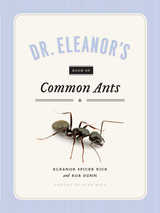
No longer! In this witty, accessible, and beautifully illustrated guide, Eleanor Spicer Rice, Alex Wild, and Rob Dunn metamorphose creepy-crawly revulsion into myrmecological wonder. Emerging from Dunn’s ambitious citizen science project Your Wild Life (an initiative based at North Carolina State University), Dr. Eleanor’s Book of Common Ants provides an eye-opening entomological overview of the natural history of species most noted by project participants—and even offers tips on keeping ant farms in your home. Exploring species from the spreading red imported fire ant to the pavement ant, and featuring Wild’s stunning photography, this guide will be a tremendous resource for teachers, students, and scientists alike. But more than this, it will transform the way we perceive the environment around us by deepening our understanding of its littlest inhabitants, inspiring everyone to find their inner naturalist, get outside, and crawl across the dirt—magnifying glass in hand.
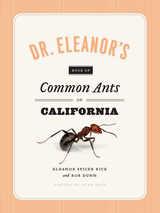
No longer! In this witty, accessible, and beautifully illustrated guide, Eleanor Spicer Rice, Alex Wild, and Rob Dunn metamorphose creepy-crawly revulsion into myrmecological wonder. Emerging from Dunn’s ambitious citizen science project Your Wild Life (an initiative based at North Carolina State University) and the work of Brian Fisher with the California Academy of Sciences, Dr. Eleanor’s Book of Common Ants of California provides an eye-opening entomological overview of the natural history of California’s species most noted by project participants—and even offers tips on keeping ant farms in your home. Exploring species from the high noon and harvester ants to the honeypot and acrobat ants, and featuring Wild’s stunning photography, this guide will be a tremendous resource for teachers, students, and scientists alike. But more than this, it will transform the way Californians perceive the environment around them by deepening their understanding of its littlest inhabitants, inspiring everyone to find their inner naturalist, get outside, and crawl across the dirt—magnifying glass in hand.
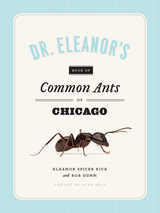
No longer! In this witty, accessible, and beautifully illustrated guide, Eleanor Spicer Rice, Alex Wild, and Rob Dunn metamorphose creepy-crawly revulsion into myrmecological wonder. Emerging from Dunn’s ambitious citizen science project Your Wild Life (an initiative based at North Carolina State University), Dr. Eleanor’s Book of Common Ants of Chicago provides an eye-opening entomological overview of the natural history of Chicago’s species most noted by project participants—and even offers tips on keeping ant farms in your home. Exploring species from the hobbit ant to the tiny trapjaw ant, and featuring contributions from E. O. Wilson and Field Museum ant scientist Corrie Moreau as well as Wild’s stunning photography, this guide will be a tremendous resource for teachers, students, and scientists alike. But more than this, it will transform the way Chicagoans perceive the environment around them by deepening their understanding of its littlest inhabitants, inspiring everyone to find their inner naturalist, get outside, and crawl across the dirt—magnifying glass in hand.
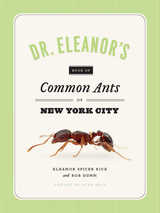
No longer! In this witty, accessible, and beautifully illustrated guide, Eleanor Spicer Rice, Alex Wild, and Rob Dunn metamorphose creepy-crawly revulsion into myrmecological wonder. Emerging from Dunn’s ambitious citizen science project Your Wild Life (an initiative based at North Carolina State University), Dr. Eleanor’s Book of Common Ants of New York City provides an eye-opening entomological overview of the natural history of New York’s species most noted by project participants—and even offers insight into the ant denizens of the city’s subways and Central Park. Exploring species from the honeyrump ant to the Japanese crazy ant, and featuring Wild’s stunning photography as well as tips on keeping ant farms in your home, this guide will be a tremendous resource for teachers, students, and scientists alike. But more than this, it will transform the way New Yorkers perceive the environment around them by deepening their understanding of its littlest inhabitants, inspiring everyone to find their inner naturalist, get outside, and crawl across the dirt—magnifying glass in hand.
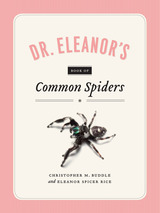
No longer! In this witty, accessible, and beautifully illustrated guide, Christopher M. Buddle and Eleanor Spicer Rice metamorphose creepy-crawly revulsion into spider wonder. Emerging from ambitious citizen science project Your Wild Life (an initiative based at North Carolina State University), Dr. Eleanor's Book of Common Spiders provides an eye-opening arachnological overview of the natural history of species most noted by project participants, showcasing some of the fascinating spiders found in our attics and tents, front lawns and forests—and even introducing us to spiders that fish. Exploring species from the tiny (but gymnastic) zebra jumping spider to the naturally shy and woefully misunderstood black widow, this guide will be a tremendous resource for teachers, students, and scientists alike. But more than this, it will transform the way we perceive the environment around us by deepening our understanding of its littlest inhabitants, inspiring all of us to find our inner naturalist, get outside, and crawl across the dirt—magnifying glass in hand.
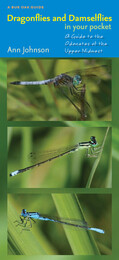
Just as more and more people enjoy watching birds and butterflies, watching the many shimmering dragonflies and damselflies—collectively called odonates, from Odonata, the name of this order of aquatic insects—has become a popular pastime. Now Dragonflies and Damselflies in Your Pocket introduces us to 50 of the showiest odonates of the Upper Midwest.
Ann Johnson’s text is clear and informative and her photographs are stunning; it is impossible to look at them without wanting to head out for the nearest stream and search for the living insects. In addition to providing useful general information about broad-winged damsels, spreadwings, pond damsels, darners, clubtails, cruisers, emeralds, and skimmers, she includes common and scientific names, sizes, general flight seasons, and the best habitats in which to find each species: rocky rivers, wetlands, ponds, still waters, and so on.
With their extremely large eyes, elongated transparent wings, long and slender abdomens, and prehensile extendible jaws, dragonflies and damselflies are efficient hunters and quick, darting fliers. Their beauty and their behavior make them delightful subjects for birdwatchers and other nature lovers. Dragonflies and Damselflies in Your Pocket will greatly enhance your appreciation of these winged marvels.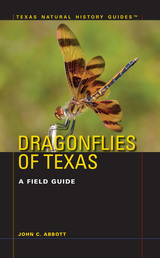
Dragonflies and damselflies (together known as Odonata) are among the most remarkably distinctive insects in their appearance and biology, and they have become some of the most popular creatures sought by avocational naturalists. Texas hosts 160 species of dragonflies, nearly half of the 327 species known in North America, making the state a particularly good place to observe dragonflies in their natural habitats.
Dragonflies of Texas is the definitive field guide to these insects. It covers all 160 species with in situ photographs and detailed anatomical images as needed. Each species is given a two-page spread that includes photographs of both sexes and known variations when possible, key features, a distribution map, identification, discussion of similar species, status in Texas, habitat, seasonality, and general comments. Many of the groups also have comparative plates that show anatomically distinctive characteristics. In addition to the species accounts, John Abbott discusses dragonfly anatomy, life history, conservation, names, and photography. He also provides information on species that may eventually be discovered in Texas, state and global conservation rankings, seasonality of all species in chronological order, and additional resources and publications on the identification of dragonflies.
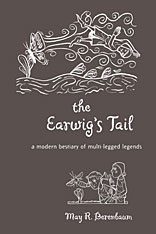
Throughout the Middle Ages, enormously popular bestiaries presented people with descriptions of rare and unusual animals, typically paired with a moral or religious lesson. The real and the imaginary blended seamlessly in these books—at the time, the existence of a rhinoceros was as credible as a unicorn or dragon. Although audiences now scoff at the impossibility of mythological beasts, there remains an extraordinary willingness to suspend skepticism and believe wild stories about nature, particularly about insects and their relatives in the Phylum Arthropoda.
In The Earwig’s Tail, entomologist May Berenbaum and illustrator Jay Hosler draw on the powerful cultural symbols of these antiquated books to create a beautiful and witty bestiary of the insect world. Berenbaum’s compendium of tales is an alphabetical tour of modern myths that humorously illuminates aerodynamically unsound bees, ear-boring earwigs, and libido-enhancing Spanish flies. She tracks down the germ of scientific truth that inspires each insect urban legend and shares some wild biological lessons, which, because of the amazing nature of the insect world, can be more fantastic than even the mythic misperceptions.
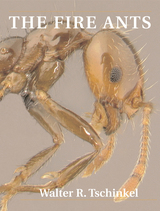
Walter Tschinkel's passion for fire ants has been stoked by over thirty years of exploring the rhythm and drama of Solenopsis invicta's biology. Since South American fire ants arrived in Mobile, Alabama, in the 1940s, they have spread to become one of the most reviled pests in the Sunbelt.
In Fire Ants Tschinkel provides not just an encyclopedic overview of S. invicta--how they found colonies, construct and defend their nests, forage and distribute food, struggle among themselves for primacy, and even relocate entire colonies--but a lively account of how research is done, how science establishes facts, and the pleasures and problems of a scientific career.
Between chapters detailed enough for experts but readily accessible to any educated reader, "interludes" provide vivid verbal images of the world of fire ants and the people who study them. Early chapters describe the several failed, and heavily politically influenced, eradication campaigns, and later ones the remarkable spread of S. invicta's "polygyne" form, in which nests harbor multiple queens and colonies reproduce by "budding." The reader learns much about ants, the practice of science, and humans' role in the fire ant's North American success.
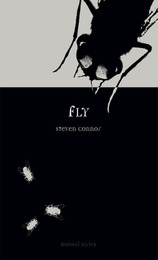
Fly explores the history of this much-maligned creature and then turns to examine its newfound redemption through science. The secrets of the fly’s versatile powers of flight, Steven Connor reveals, are only beginning to be understood and appreciated. Its eyes and wings, for instance, have evolved so perfectly that they provide inspiration for some of today’s most daring technological and scientific innovations. And the humble fruit fly, Connor demonstrates, stands at the center of revolutionary advances in genetic research.
Connor delights in tracking his lowly subject through myth, literature, poetry, painting, film, and biology. Humans live in close and intimate quarters with flies, but Fly is the first book to give these common creatures their due.
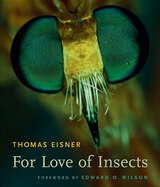
Imagine beetles ejecting defensive sprays as hot as boiling water; female moths holding their mates for ransom; caterpillars disguising themselves as flowers by fastening petals to their bodies; termites emitting a viscous glue to rally fellow soldiers--and you will have entered an insect world once beyond imagining, a world observed and described down to its tiniest astonishing detail by Thomas Eisner. The story of a lifetime of such minute explorations, For Love of Insects celebrates the small creatures that have emerged triumphant on the planet, the beneficiaries of extraordinary evolutionary inventiveness and unparalleled reproductive capacity.
To understand the success of insects is to appreciate our own shortcomings, Eisner tells us, but never has a reckoning been such a pleasure. Recounting exploits and discoveries in his lab at Cornell and in the field in Uruguay, Australia, Panama, Europe, and North America, Eisner time and again demonstrates how inquiry into the survival strategies of an insect leads to clarifications beyond the expected; insects are revealed as masters of achievement, forms of life worthy of study and respect from even the most recalcitrant entomophobe. Filled with descriptions of his ingenious experiments and illustrated with photographs unmatched for their combination of scientific content and delicate beauty, Eisner's book makes readers participants in the grand adventure of discovery on a scale infinitesimally small, and infinitely surprising.
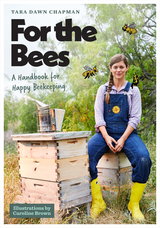
A handbook for what to expect the first year of beekeeping and beyond.
The path to becoming a successful beekeeper begins with a deep understanding of the bees themselves. Taking an approach that is both holistic and practical, Tara Chapman, founder and operator of Austin’s beloved Two Hives Honey, begins with a primer on honey bee biology and nutrition as well as beehive architecture. (Did you ever wonder why honey combs are composed of tiny hexagons?) A little scientific knowledge goes a long way: a beekeeper who understands how these fascinating creatures work will be better equipped to recognize a particular colony’s needs, make sound decisions when the unexpected happens, and adapt their care regimen to changing conditions. Moving beyond the basics, Chapman shows potential beekeepers how to spot pests and diseases; manage swarms (those bees aren’t angry; they’re just looking for a good home); and, of course, harvest delicious homegrown honey.
Imbued with the joy of the beekeeping journey, For the Bees provides practical visual explanations through appealing illustrations, that, alongside Chapman’s own stories from the bee yard, share the charms of these essential insects.
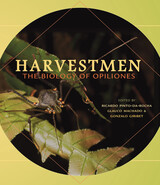
This is the first comprehensive treatment of a major order of arachnids featuring more than 6,000 species worldwide, familiar in North America as daddy-longlegs but known scientifically as the Opiliones, or harvestmen. The 25 authors provide a much-needed synthesis of what is currently known about these relatives of spiders, focusing on basic conceptual issues in systematics and evolutionary ecology, making comparisons with other well-studied arachnid groups, such as spiders and scorpions.
Broad in scope, the volume is aimed at raising relevant questions from a diversity of fields, indicating areas in which additional research is needed. The authors focus on both the unique attributes of harvestmen biology, as well as on biological studies conducted with harvestmen species that contribute to the understanding of behavior and evolutionary biology in general. By providing a broad taxonomic and ecological background for understanding this major arachnid group, the book should give field biologists worldwide the means to identify specimens and provide an invaluable reference for understanding harvestmen diversity and biology.
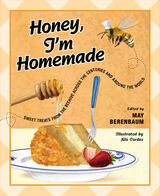
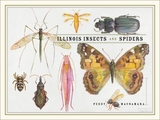
Marrying art and entomology, Illinois Insects and Spiders is a unique introduction to local biodiversity. Artist Peggy Macnamara celebrates the state's burgeoning insect and spider populations with twenty-seven color plates of beautiful renderings of numerous species, organized both taxonomically and thematically. The insects on each plate are depicted true to scale in relation to one another and are displayed approximately ten times larger than life size. Accompanying each plate are lively captions-written by Field Museum curators and collection managers-that identify the species and reveal their interesting behaviors and unique habitats.
Illinois Insects and Spiders encourages readers to explore the biodiversity at their feet-in the shiny beetles on the ground-and in the air-in the glint of a lightning bug in summer. More than a traditional field guide, Illinois Insects and Spiders is the rare book that combines lush artwork with the science of natural history, bringing both closer to the general reader.
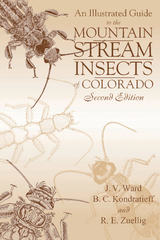
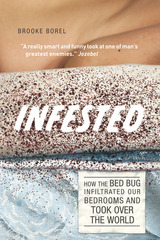
In Infested, Borel introduces readers to the biological and cultural histories of these amazingly adaptive insects, and the myriad ways in which humans have responded to them. She travels to meet with scientists who are rearing bed bug colonies—even by feeding them with their own blood (ouch!)—and to the stages of musicals performed in honor of the pests. She explores the history of bed bugs and their apparent disappearance in the 1950s after the introduction of DDT, charting how current infestations have flourished in direct response to human chemical use as well as the ease of global travel. She also introduces us to the economics of bed bug infestations, from hotels to homes to office buildings, and the expansive industry that has arisen to combat them.
Hiding during the day in the nooks and seams of mattresses, box springs, bed frames, headboards, dresser tables, wallpaper, or any clutter around a bed, bed bugs are thriving and eager for their next victim. By providing fascinating details on bed bug science and behavior as well as a captivating look into the lives of those devoted to researching or eradicating them, Infested is sure to inspire at least a nibble of respect for these tenacious creatures—while also ensuring that you will peek beneath the sheets with prickly apprehension.

Insects inhabit an often unexamined microcosmos, pursuing lives that are often strange beyond our wildest imaginings. From the dawn of humanity, our six-legged fellow Earthlings have repelled and enthralled us. Humans have exterminated, eaten, domesticated, and even excommunicated insects. We collect them, we curse them, and we have penned a surprising body of literature about them.
Insect Lives: Stories of Mystery and Romance from a Hidden World offers an entertaining and informative survey of the human fascination, dreadful and otherwise, with insects diabolical and divine, from accounts in the Bible and Aristotle to the writings of Charles Darwin and the great nineteenth-century naturalists sending home accounts from the rain forest. Highlighted here are observations from E. O. Wilson, Jean-Henri Fabré, David Quammen, May Berenbaum, Roger Swain, William Wordsworth, A. S. Byatt, Gary Larson and more than sixty other writers who tell of the mystery and romance of that other, hidden world beneath our feet and beyond our rolled-up newspapers.
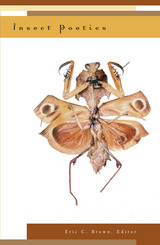
In Insect Poetics, the first book to comprehensively explore the cultural and textual meanings of bugs, editor Eric Brown argues that insects are humanity’s “other.” In order to be experienced, the insect world must be mediated by art or technology (as in the case of an ant farm or Kafka’s Metamorphoses) while humans observe, detached and fascinated.
In eighteen original essays, this book illuminates the ways in which our human intellectual and cultural models have been influenced by the natural history of insects. Through critical readings contributors address such topics as performing insects in Shakespeare’s Coriolanus, the cockroach in the contemporary American novel, the butterfly’s “voyage out” in Virginia Woolf, and images of insect eating in literature and popular culture. In surprising ways, contributors tease out the particularities of insects as cultural signifiers and propose ways of thinking about “insectivity,” suggesting fertile cross-pollinations between entomology and the arts, between insects and the humanities.
Contributors: May Berenbaum, Yves Cambefort, Marion W. Copeland, Nicky Coutts, Bertrand Gervais, Sarah Gordon, Cristopher Hollingsworth, Heather Johnson, Richard J. Leskosky, Tony McGowan, Erika Mae Olbricht, Marc Olivier, Roy Rosenstein, Rachel Sarsfield, Charlotte Sleigh, Andre Stipanovic.
Eric C. Brown is assistant professor of English at the University of Maine at Farmington. He has written previously about insects and eschatology in Edmund Spenser’s Muiopotmos.
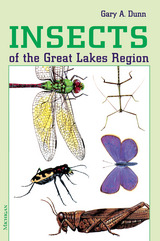
The insects are the world's most amazing animals and comprise over eighty-five percent of the known animal species. Insects of the Great Lakes Region is the first comprehensive guide to document the rich and diverse insect fauna of the Great Lakes region. In Insects of the Great Lakes Region, educators, insect enthusiasts, and the general public will find high-quality, well-presented, easy-to-understand information with over 250 illustrations of the insects found in yards, gardens, fields, and forests. Among the topics discussed are the geological, biological, and entomological history of the Great Lakes region, the distributional patterns of insects in the Great Lakes region, and insect classification and identification. Appendixes guide the reader to entomological organizations, entomological periodicals, public insect collections, regulations on collecting insects from public lands in the Great Lakes region, as well as rare, threatened, and endangered insects. This guide shows the amateur entomologist everything he needs to know, from where to collect milkweed bugs to how often to feed his pet tarantula.
Gary Dunn is Executive Director and Editor, Young Entomologists' Society, Inc., International Headquarters, Lansing, Michigan.


The Mayflies of North and Central America was first published in 1976. Minnesota Archive Editions uses digital technology to make long-unavailable books once again accessible, and are published unaltered from the original University of Minnesota Press editions.
Mayflies have fascinated man for centuries because of the brief span of their adult lives. These aquatic insects spend most of their lives as nymphs in water, then develop into winged stages and soon die, most species having an adult life of only two or three days. This brevity is implied in the very name of the order, Ephemeroptera.
The mayflies are almost worldwide in distribution, being found everywhere except in Antarctica, the extreme Arctic, and many small oceanic islands. All by three of the twenty families in the world occur in North or Central America, the regions covered in this volume. The book provides a modern, useful, and well-illustrated key to the adults and nymphs. Data on habitats, behavior, and life history are given for each genus. Characteristics of nymphs and adults are given for families, subfamilies, and genera, with brief accounts for extralimital families.
A discussion of methods of collecting and preserving specimens precedes the main portion of the text. The book is generously illustrated with drawings, photographs, and a map.
The role of aquatic insects as indicators of water pollution has received increasing attention, and in this connection this book will be of special interest to those concerned with pollution problems. Mayflies, besides indicating the presence of pollutants, also help remove such substances from the waters, the authors explain.
As a basic reference work, the book is essential for all biological science libraries. Many fly-fishermen are amateur students of mayflies, since the nymphs of larger species are used as bait. With the help of this volume the fisherman can acquire a greater knowledge of aquatic entomology and relate to his sport.

Insects that are the least bit social may gather in modest groups, like the dozen or so sawfly larvae feeding on a pine needle, or they may form huge masses, like a swarm of migratory locusts in Africa or a cloud of mayflies at the edge of a midwestern lake or river. Why these insects get together and what they get out of their associations are questions finely and fully considered in this learned and entertaining look at the group behavior and social lives of a wide array of bugs.
The groups that Gilbert Waldbauer discusses here are not as complex or tightly organized as the better-known societies of termites, wasps, ants, and bees. Some, like the mayflies, come together merely because they emerge from the water in the same place at the same time. But others, like swarms of locusts, are loosely organized, the individual insects congregating to migrate together for distances of hundreds of miles. And yet others form a simple cooperative society, such as the colony of tent caterpillars that weaves a silken tent to house the whole group.
Waldbauer tells us how individuals in these and other insect aggregations communicate (or don't), how they coordinate their efforts, how some congregate the better to mate, how some groups improve the temperature and humidity of their microenvironment, and how others safeguard themselves (or the future of their kind) by amassing in such vast numbers as to confound predators.
As engaging and authoritative as Waldbauer's previous books, Millions of Monarchs, Bunches of Beetles will enlighten and delight those who know their insects well and those who wish to know them better.
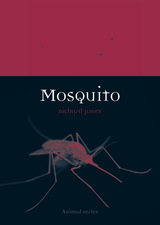
Bug zappers were invented for one purpose: to kill mosquitoes, the bane of many summer evenings, camping trips, and exotic vacations. These blood-sucking insects do more than leave us with itchy bites, though. The diseases they carry and inject, such as yellow fever, dengue fever, and the West Nile virus, make them responsible for more human deaths than any other animal. The most deadly of these, malaria, has been mostly eradicated from the northern hemisphere, but it continues to pose a mortal threat in developing countries. It kills nearly 700,000 of the 350 million that succumb to the infection each year, and the majority of the deaths occur in sub-Saharan Africa.
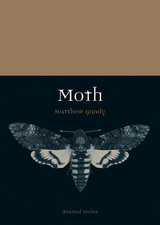
Gandy shows that the study of moths formed an integral part of early natural history. Many thousands of drawings, paintings, and physical specimens remain in museum collections, and in recent years there has been a renewed surge of interest facilitated by advances in digital photography, the internet, and new cartographic projects that have enabled direct collaboration between amateur experts and scientific research projects. He explores the rich history of vernacular names, which speaks to a significant place for moths in early cultures of nature. Names such as the Merveille-du-Jour, the Green Brindled Crescent, or the Clifden Nonpareil evoke a sense of wonder that connects disparate fields such as folklore, the history of place, and early scientific texts. With wingspans ranging in size from a few millimetres to nearly a foot, moths display an extraordinary diversity of evolutionary adaptions, which Gandy captures here.

Having received such lavish praise for the first volume of his definitive taxonomic handbook, Daniel Otte now turns his attention to the bandwing grasshoppers. As before, the book includes:
– Highly detailed, full-color drawings of all species, including more than one color phase when appropriate;
– Illustrated keys and lists of principal recognition features;
– Information on distributional limits, habitat preferences, ecology, behavior, and life cycle;
– Excellent point-distribution maps;
– Pertinent references, taxonomic index, history of name changes, and an explanation of the characters used to derive phylogenies.
Like its predecessor, this volume will be useful to scientists in agriculture, environmental assessment, biogeography, grassland ecology, and insect taxonomy. It will also appeal to amateur naturalists.
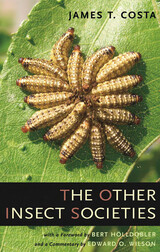
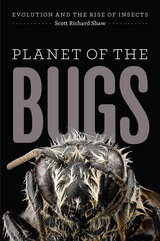
Leaving no stone unturned, Shaw explores how evolutionary innovations such as small body size, wings, metamorphosis, and parasitic behavior have enabled insects to disperse widely, occupy increasingly narrow niches, and survive global catastrophes in their rise to dominance. Through buggy tales by turns bizarre and comical—from caddisflies that construct portable houses or weave silken aquatic nets to trap floating debris, to parasitic wasp larvae that develop in the blood of host insects and, by storing waste products in their rear ends, are able to postpone defecation until after they emerge—he not only unearths how changes in our planet’s geology, flora, and fauna contributed to insects’ success, but also how, in return, insects came to shape terrestrial ecosystems and amplify biodiversity. Indeed, in his visits to hyperdiverse rain forests to highlight the current insect extinction crisis, Shaw reaffirms just how crucial these tiny beings are to planetary health and human survival.
In this age of honeybee die-offs and bedbugs hitching rides in the spines of library books, Planet of the Bugs charms with humor, affection, and insight into the world’s six-legged creatures, revealing an essential importance that resonates across time and space.
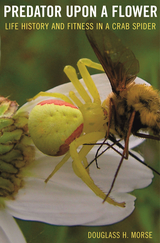
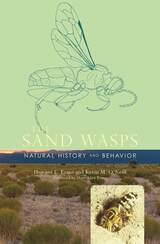
Howard Ensign Evans was a brilliant ethologist and systematist for whom the joy of science included lying on his belly in some remote location, digging out and diagramming a wasp’s nest. During his career, Evans described over 900 species and authored more than a dozen books, both technical and popular, on a wide range of entomological and natural history subjects. Upon his death in 2002, he left behind an unfinished manuscript, intended as an update (though not a revision) of his classic 1966 work, The Comparative Ethology and Evolution of the Sand Wasps. Kevin O’Neill, Evans’s former student and coauthor, has completed and enlarged Evans’s manuscript to provide coverage of all sand-wasp tribes in Evan’s earlier book. The result is a tribe-by-tribe, species-by-species review of studies of the Bembicinae that have appeared over the last four decades.
The Sand Wasps: Natural History and Behavior already has been hailed by specialists as a new bible for those working on solitary wasps and an essential reference for scientists more broadly interested in insect behavioral evolution.
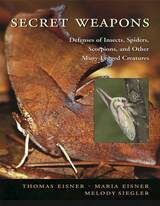
Mostly tiny, infinitely delicate, and short-lived, insects and their relatives--arthropods--nonetheless outnumber all their fellow creatures on earth. How lowly arthropods achieved this unlikely preeminence is a story deftly and colorfully told in this follow-up to the award-winning For Love of Insects. Part handbook, part field guide, part photo album, Secret Weapons chronicles the diverse and often astonishing defensive strategies that have allowed insects, spiders, scorpions, and other many-legged creatures not just to survive, but to thrive.
In sixty-nine chapters, each brilliantly illustrated with photographs culled from Thomas Eisner's legendary collection, we meet a largely North American cast of arthropods--as well as a few of their kin from Australia, Europe, and Asia--and observe at firsthand the nature and extent of the defenses that lie at the root of their evolutionary success. Here are the cockroaches and termites, the carpenter ants and honeybees, and all the miniature creatures in between, deploying their sprays and venom, froth and feces, camouflage and sticky coatings. And along with a marvelous bug's-eye view of how these secret weapons actually work, here is a close-up look at the science behind them, from taxonomy to chemical formulas, as well as an appendix with instructions for studying chemical defenses at home. Whether dipped into here and there or read cover to cover, Secret Weapons will prove invaluable to hands-on researchers and amateur naturalists alike, and will captivate any reader for whom nature is a source of wonder.

Although the honeybee is without doubt man's favorite social insect, and the most studied by him, there are twenty thousand other species of bees, many of which are social. This book is the first to offer a systematic account of social behavior in the entire super family Apoidea. Of all the social insects, the various species of bees exhibit perhaps the broadest spectrum of social behavior, including intermediate stages which are scarce or totally extinct in other groups; in this respect the bees are particularly appropriate subjects for evolutionary study.
With the aid of more than 200 illustrations, Charles Michener characterizes and describes all levels of social organization in the bees—from simple aggregations of solitary nests to elaborate, eusocial colonies. He reviews the entire repertoire of social behavior in bees and gives detailed attention to mechanisms of communication, division of labor, determination of sex and caste, maintenance and control of nest conditions, and organization of defense. In a major chapter the evolutionary context of the bee societies is extensively explored; the author examines the selective advantages and disadvantages entailed in evolving nonreproductive castes, the problem of multiple, independent origins of eusociaI behavior, and the question of “direction” in the evolution of social behavior. The final section is an account of the life history and behavioral attributes of each of the groups of social bees.
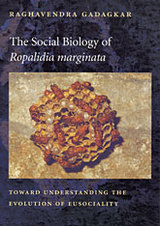
In this book, the biologist Raghavendra Gadagkar focuses on the single species he has worked on throughout his career. Found throughout southern India, Ropalidia marginata is a primitively eusocial wasp--a species in which queens and workers do not differ morphologically and even the latter retain the ability to reproduce. New colonies may be founded by a single fertile female or by several, which then share reproductive and worker duties.
R. marginata has provided Gadagkar with a unique opportunity to study the evolution of eusociality; its long-lived dynasties can continue almost indefinitely, as old or weakened queens are replaced by young and healthy ones and new colonies are founded throughout the year. Understanding such primitively eusocial species is crucial, Gadagkar argues, if we are to understand the evolution of the greater degrees of sociality found in other wasp species and in ants, termites, and bees. His years of study have led him to believe that ecological, physiological, and demographic factors can be more important than genetic relatedness in the selection for or against social traits.
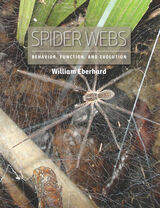
As Eberhard reveals, the extraordinary diversity of webs includes ingenious solutions to gain access to prey in esoteric habitats, from blazing hot and shifting sand dunes (to capture ants) to the surfaces of tropical lakes (to capture water striders). Some webs are nets that are cast onto prey, while others form baskets into which the spider flicks prey. Some aerial webs are tramways used by spiders searching for chemical cues from their prey below, while others feature landing sites for flying insects and spiders where the spider then stalks its prey. In some webs, long trip lines are delicately sustained just above the ground by tiny rigid silk poles.
Stemming from the author’s more than five decades observing spider webs, this book will be the definitive reference for years to come.
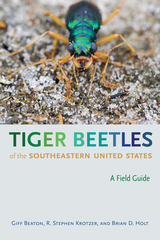
Tiger beetles are brightly colored and metallic beetles, often with ivory or cream-colored markings. They are most abundant and diverse in habitats near bodies of water with sandy or clay soils and can be found along rivers, on sea and lake shores, on sand dunes, around dry lakebeds, on clay banks, or on woodland paths. Conservatively estimated, the group comprises more than 2,600 species worldwide.
Tiger Beetles of the Southeastern United States identifies and describes 52 taxa (42 species and 10 additional subspecies) of tiger beetles that occur in Alabama, Florida, Georgia, Mississippi, North Carolina, South Carolina, and Tennessee. Stunning close-up photographs accompany current taxonomic and biological information in a volume designed for a growing audience of enthusiastic amateurs and professionals alike.
The authors provide an in-depth description of the anatomy, life cycle, and behavior of tiger beetles; an overview of the various southeastern habitats in which they occur; instructions for finding, identifying, and photographing them in the wild; and the conservation status of various species. The individual species accounts include stunning, detailed images, flight season charts, county-level regional distribution maps, and discussion of identifying features, habitat, similar species, and subspecies when applicable. The appendix includes two species previously found in Florida but no longer known to exist there.
The result is the most complete field guide to date on tiger beetles in the region. With more than 230 images of beetles and their habitats, as well as life history and distribution data, this book is essential for tiger beetle enthusiasts, naturalists of all kinds, photographers, biologists, and teachers throughout the region.
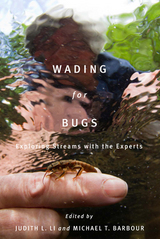
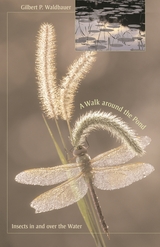
A water strider darts across a pond, its feet dimpling the surface tension; a giant water bug dives below, carrying his mate’s eggs on his back; hidden among plant roots on the silty bottom, a dragonfly larva stalks unwary minnows. Barely skimming the surface, in the air above the pond, swarm mayflies with diaphanous wings. Take this walk around the pond with Gilbert Waldbauer and discover the most amazingly diverse inhabitants of the freshwater world.
In his hallmark companionable style, Waldbauer introduces us to the aquatic insects that have colonized ponds, lakes, streams, and rivers, especially those in North America. Along the way we learn about the diverse forms these arthropods take, as well as their remarkable modes of life—how they have radiated into every imaginable niche in the water environment, and how they cope with the challenges such an environment poses to respiration, vision, thermoregulation, and reproduction. We encounter the caddis fly larva building its protective case and camouflaging it with stream detritus; green darner dragonflies mating midair in an acrobatic wheel formation; ants that have adapted to the tiny water environment within a pitcher plant; and insects whose adaptations to the aquatic lifestyle are furnishing biomaterials engineers with ideas for future applications in industry and consumer goods.
While learning about the evolution, natural history, and ecology of these insects, readers also discover more than a little about the scientists who study them.
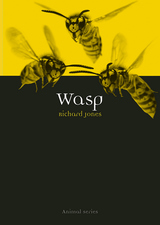
Leading entomologist Richard Jones redresses the balance in this enlightening and entertaining guide to the natural and cultural history of these powerful arthropod carnivores. Jones delves into their complex nesting and colony behavior, their fascinating caste system, and their major role at the center of many food webs. Drawing on up-to-date scientific concepts and featuring many striking color illustrations, Jones pushes past the sting, showing exactly why wasps are worthy of greater understanding and appreciation.
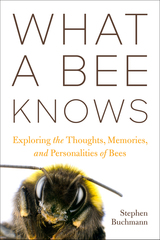
Although their brains are incredibly small—just one million neurons compared to humans’ 100 billion—bees have remarkable abilities to navigate, learn, communicate, and remember. In What a Bee Knows, entomologist Stephen Buchmann explores a bee’s way of seeing the world and introduces the scientists who make the journey possible. We travel into the field and to the laboratories of noted bee biologists who have spent their careers digging into the questions most of us never thought to ask (for example: Do bees dream? And if so, why?). With each discovery, Buchmann’s insatiable curiosity and sense of wonder is infectious.
What a Bee Knows will challenge your idea of a bee’s place in the world—and perhaps our own. This lively journey into a bee’s mind reminds us that the world is more complex than our senses can tell us.
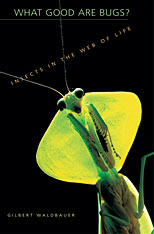
We shriek about them, slap and spray them, and generally think of insects (when we think of them at all) as pests. Yet, if all insects, or even a critical few, were to disappear--if there were none to pollinate plants, serve as food for other animals, dispose of dead organisms, and perform other ecologically essential tasks--virtually all the ecosystems on earth, the webs of life, would unravel. This book, the first to catalogue ecologically important insects by their roles, gives us an enlightening look at how insects work in ecosystems--what they do, how they live, and how they make life as we know it possible.
In What Good Are Bugs? Gilbert Waldbauer combines anecdotes from entomological history with insights into the intimate workings of the natural world, describing the intriguing and sometimes amazing behavior of these tiny creatures. He weaves a colorful, richly textured picture of beneficial insect life on earth, from ants sowing their "hanging gardens" on Amazonian shrubs and trees to the sacred scarab of ancient Egypt burying balls of cattle dung full of undigested seeds, from the cactus-eating caterpillar (aptly called Cactoblastis) controlling the spread of the prickly pear to the prodigious honey bee and the "sanitary officers of the field"--the fly maggots, ants, beetles, and caterpillars that help decompose and recycle dung, carrion, and dead plants. As entertaining as it is informative, this charmingly illustrated volume captures the full sweep of insects' integral place in the web of life.
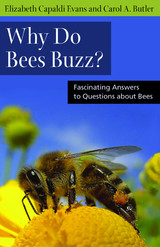
Why Do Bees Buzz? reports on the mysterious "colony collapse disorder" that has affected honey bee populations, as well as other captivating topics, such as their complex, highly social lives, and how other species of bees are unique and different from honey bees. Organized in chapters that cover everything from these provocative pollinators' basic biology to the aggressive nature of killer bees, this insightful question and answer guide provides a honeycomb of compelling facts.
With clarity and depth, bee biologist Elizabeth Capaldi Evans and coauthor Carol A. Butler examine the lives of honey bees, as well as other species such as orchid bees, bumblebees, and stingless bees. Accessible to readers on every level, and including the latest research and theory for the more sophisticated reader, the authors reveal more than one hundred critical answers to questions about the lives of bees.
Concepts about speciation, evolutionary adaptation and pollination, as well as historical details about topics such as Mayan beekeeping and the appearance of bees in rock art, are arranged in easy-to-follow sidebars that highlight the text. Color and black and white photographs and drawings enhance the beauty and usefulness of Why Do Bees Buzz?
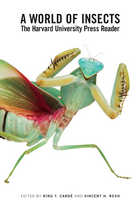
As we follow the path of a giant water bug or peer over the wing of a gypsy moth, we glimpse our world anew, at once shrunk and magnified. Owing to their size alone, insects’ experience of the world is radically different from ours. Air to them is as viscous as water to us. The predicament of size, along with the dizzying diversity of insects and their status as arguably the most successful organisms on earth, have inspired passion and eloquence in some of the world’s most innovative scientists. A World of Insects showcases classic works on insect behavior, physiology, and ecology published over half a century by Harvard University Press.
James Costa, Vincent Dethier, Thomas Eisner, Lee Goff, Bernd Heinrich, Bert Hölldobler, Kenneth Roeder, Andrew Ross, Thomas Seeley, Karl von Frisch, Gilbert Waldbauer, E. O. Wilson, and Mark Winston—each writer, in his unique voice, paints a close-up portrait of the ways insects explore their environment, outmaneuver their enemies, mate, and care for kin.
Selected by two world-class entomologists, these essays offer compelling descriptions of insect cooperation and warfare, the search for ancient insect DNA in amber, and the energy economics of hot-blooded insects. They also discuss the impact—for good and ill—of insects on our food supply, their role in crime scene investigation, and the popular fascination with pheromones, killer bees, and fire ants. Each entry begins with commentary on the authors, their topics, and the latest research in the field.
READERS
Browse our collection.
PUBLISHERS
See BiblioVault's publisher services.
STUDENT SERVICES
Files for college accessibility offices.
UChicago Accessibility Resources
home | accessibility | search | about | contact us
BiblioVault ® 2001 - 2024
The University of Chicago Press



